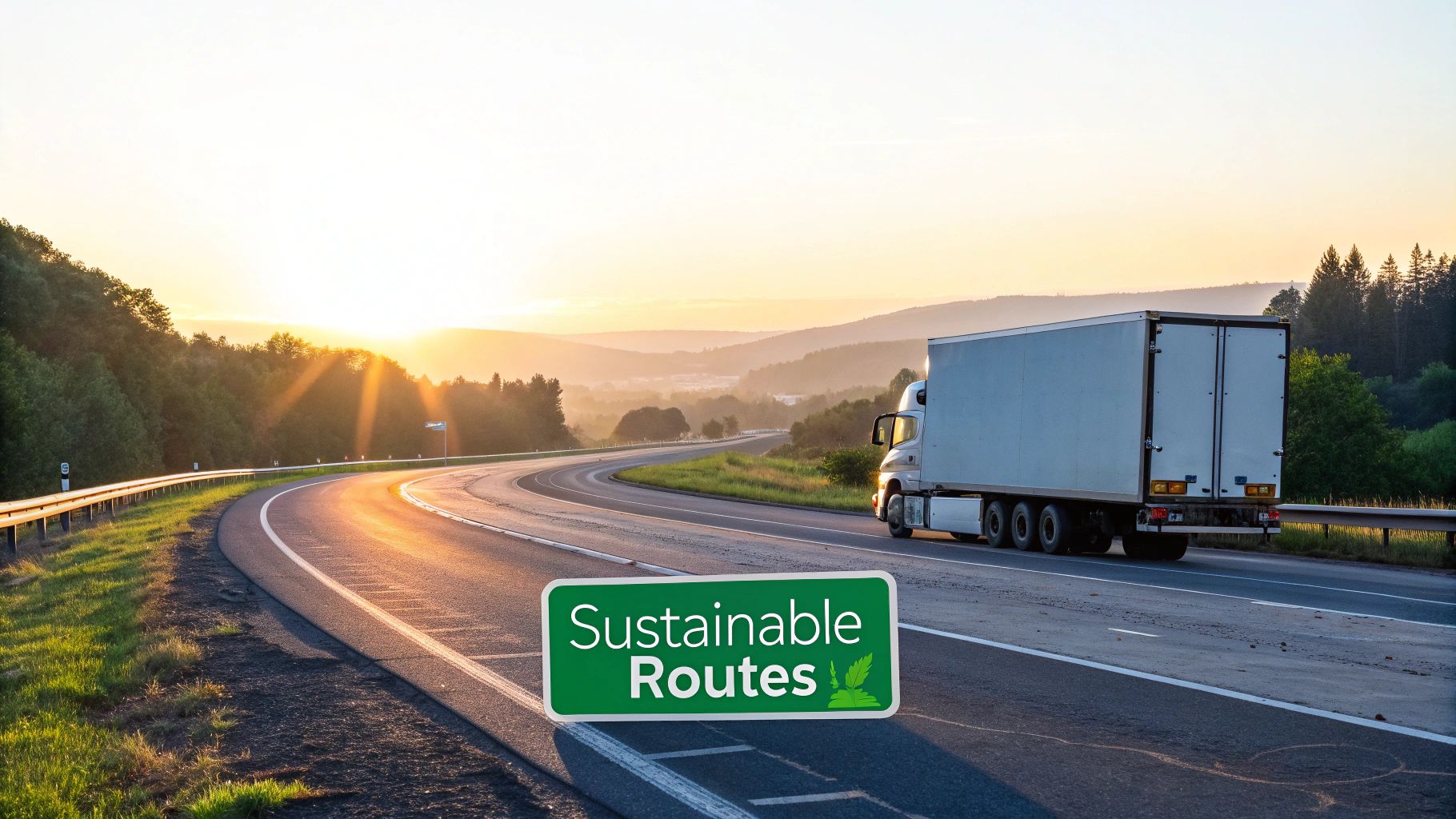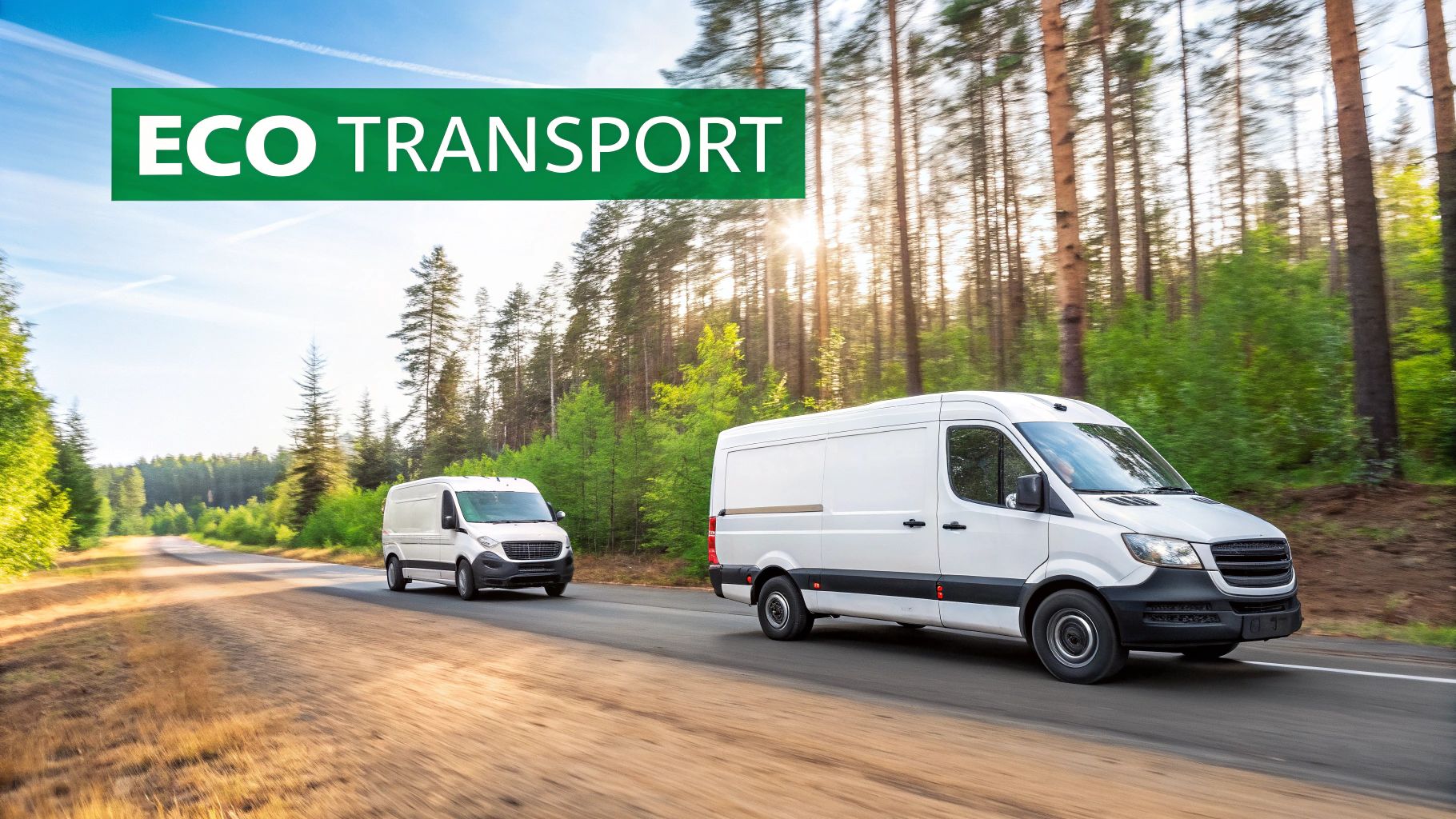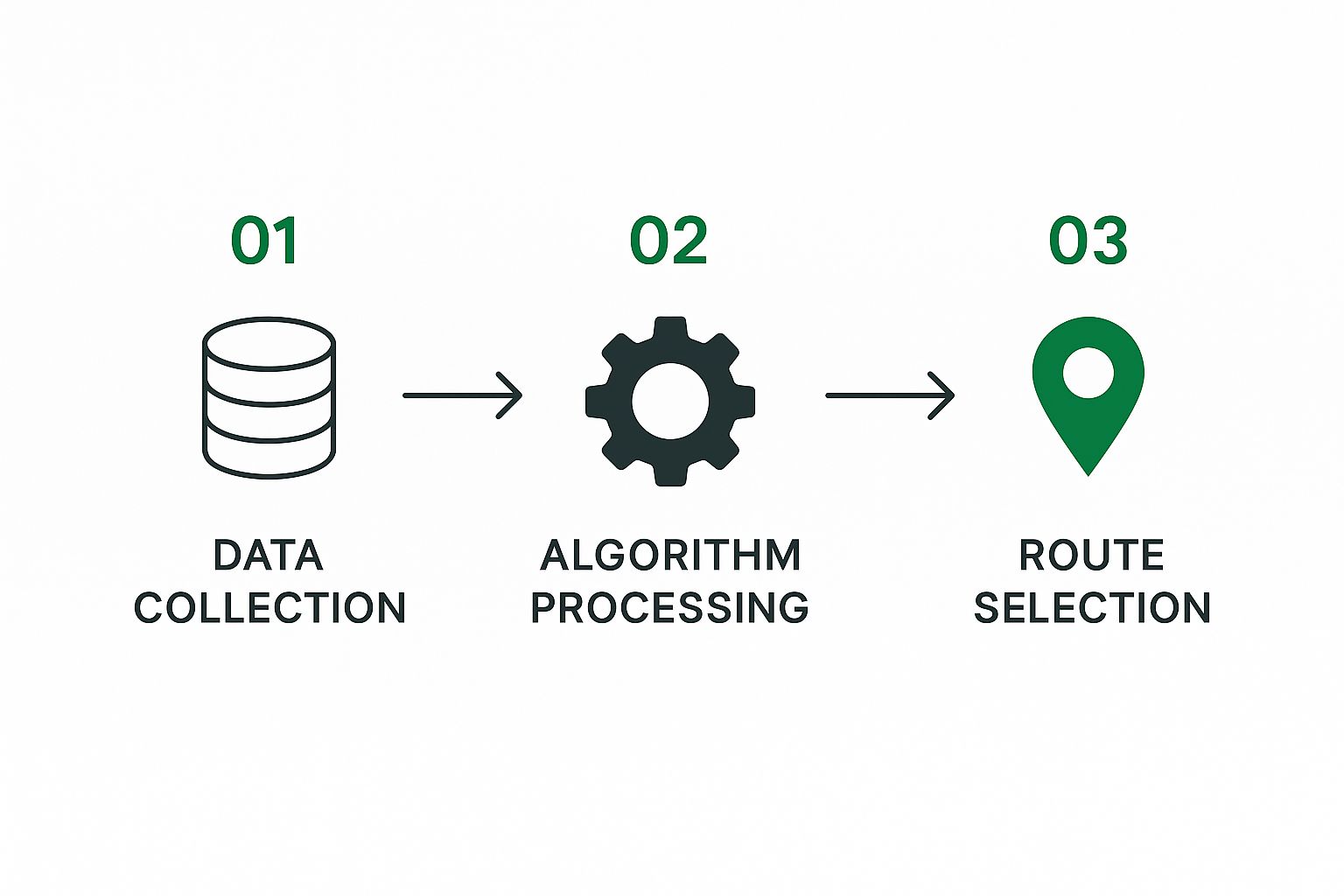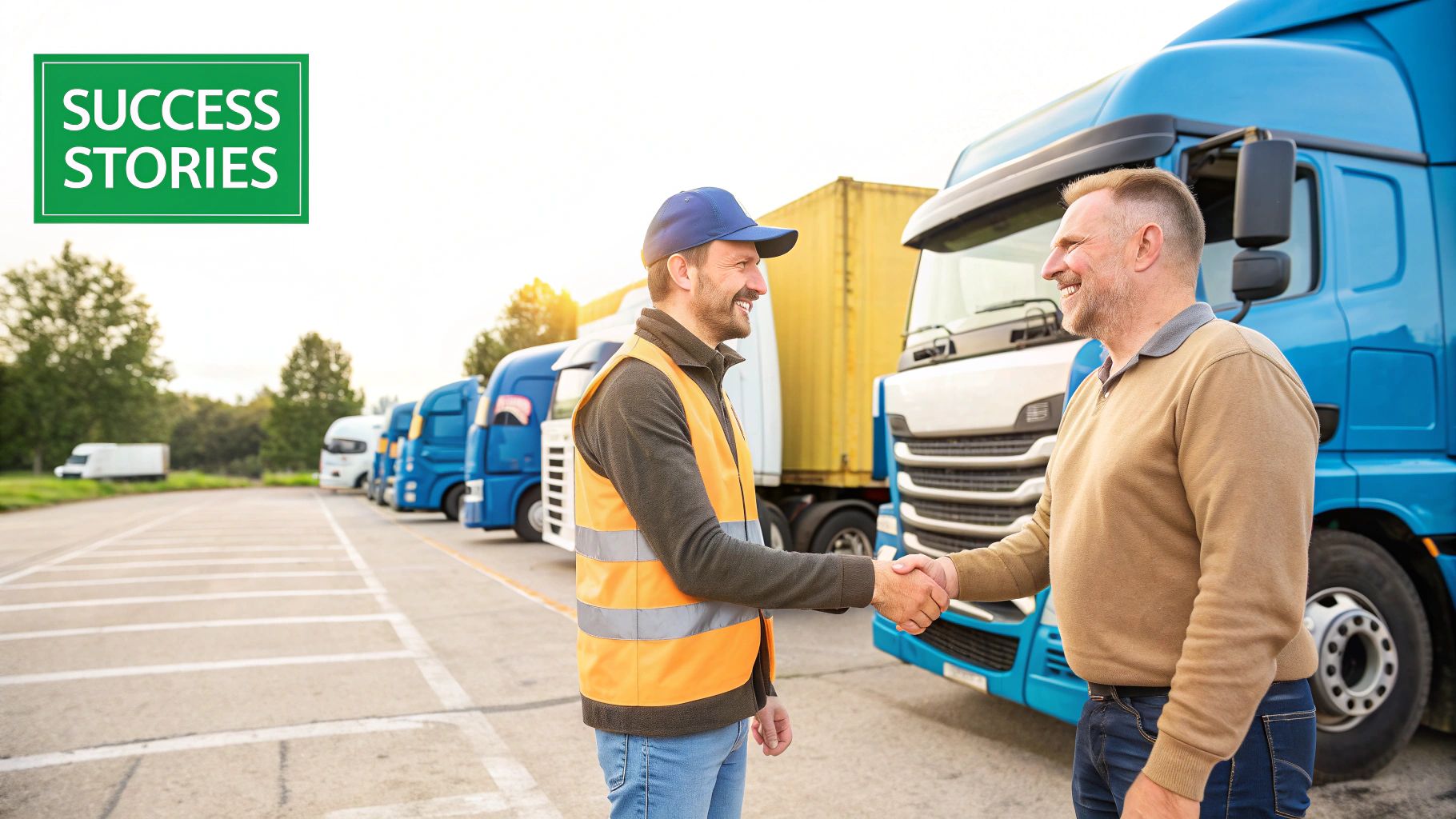Sustainable Logistics Route Optimization: Boost Efficiency & Save Costs
Karel Maly
October 6, 2025
Optimising logistics routes for sustainability is about more than just finding the quickest way from A to B. It’s a smarter approach that uses technology to plan deliveries that slash fuel consumption and CO₂ emissions, all without losing an ounce of efficiency.
This is where strategy meets responsibility. By considering real-world variables like traffic patterns, vehicle capacity, and even road gradients, you can craft routes that are genuinely efficient and better for the planet. It’s about turning your green goals into a real competitive advantage.
Why Sustainable Route Optimisation Is No Longer Optional

The move towards greener logistics isn’t just a "nice-to-have" for a corporate social responsibility report anymore. It has become a crucial business decision, driven by very real financial pressures and shifting market demands. For any business operating in the Czech Republic, ignoring sustainability now means overlooking some serious operational risks—and opportunities.
Unpredictable fuel prices and ever-stricter environmental regulations are fundamentally changing the cost of logistics. Take, for example, the recent 5% increase in tolls for heavy goods vehicles, which is now directly tied to their CO₂ emissions class. This policy doesn't just encourage greener fleets; it financially penalises less efficient ones while rewarding companies that invest in cleaner technology and smarter routing.
The Growing Influence of the Market and Consumers
The logistics sector here in the Czech Republic is booming. It was valued at around USD 15.79 billion in 2025 and is on a steady growth trajectory. Much of this expansion is driven by e-commerce, which places enormous strain on road freight—a staggering 89% of all freight movement happens on our roads.
As delivery volumes climb, so does the attention from customers. Today’s consumers are far more discerning; they actively seek out and support brands that show a real commitment to sustainability.
Adopting sustainable logistics is more than a simple operational change; it's a powerful way to build brand loyalty. When customers see you're genuinely working to reduce your carbon footprint, they're far more likely to stick with you.
Turning Environmental Responsibility into a Competitive Edge
This table breaks down how sustainability drivers connect directly to business performance.
Core Drivers for Sustainable Logistics
| Driver | Description | Business Impact |
|---|---|---|
| Financial Pressure | Rising fuel costs and new emissions-based tolls directly increase operational expenses for inefficient fleets. | Optimised routes immediately cut fuel consumption and help avoid costly penalties, improving the bottom line. |
| Consumer Demand | Customers increasingly favour brands with transparent and authentic environmental commitments. | A strong sustainability record becomes a key differentiator, attracting loyal customers and enhancing brand reputation. |
| Regulatory Compliance | Governments are introducing stricter environmental laws and regulations that logistics companies must adhere to. | Proactively adopting greener practices ensures you stay ahead of new rules, preventing future disruptions and fines. |
Ultimately, a commitment to sustainable logistics leads to a more resilient and profitable business. It’s a win-win.
Thinking about the carbon impact of your shipping operations is the critical first step. For a fantastic deep-dive into the basics and the role AI can play, check out this comprehensive guide on delivery route planning, AI, and sustainability. It’s all about shifting your mindset from seeing sustainability as an obligation to recognising it as a core business strength. You can also explore more at: https://www.carbonpunk.ai/en/blog/understanding-the-carbon-impact-of-shipping-and-logistics
Gathering the Data That Actually Drives Results

Any solid plan for sustainable logistics route optimisation lives and dies by the quality of its data. You can have the smartest algorithm in the world, but if you're feeding it garbage, you’ll get garbage out. The real goal is to dig deeper than just basic mileage, collecting the granular details that shine a light on hidden inefficiencies and unlock real carbon savings.
This all starts with pulling together information from systems that, in many businesses, don't talk to each other. Your Transportation Management System (TMS), Warehouse Management System (WMS), and vehicle telematics are sitting on goldmines of insight. The trick is getting them to share their secrets.
Sourcing Your Core Data Streams
To really see the full picture of your operation, you need to focus on a few critical data streams. Think of each one as a piece of a puzzle—on its own, it’s interesting, but together, they allow for truly intelligent and sustainable route planning.
Here’s where I always tell people to start:
- Vehicle Telematics: This is completely non-negotiable. You need hard data on fuel consumption, how long engines are left idling, vehicle speed, and instances of harsh braking. For a deep dive into how GPS tech can supercharge this, check out this excellent GPS Fleet Management Guide.
- Driver Performance Logs: This layer of data shows how individual driving styles affect fuel economy. Things like sticking to the planned route or making unscheduled stops add crucial context that telematics alone won't give you.
- Delivery Constraints: Don't just grab addresses. You need the nitty-gritty details—specific delivery time windows, vehicle size restrictions at certain drop-off points, and any unique client rules that dictate the schedule.
- Historical Traffic Data: Real-time traffic is great, but it’s reactive. By analysing historical traffic patterns for certain times and days, your system can start predicting congestion and planning smarter routes before the driver even hits the road.
I’ve seen it happen time and again: a single missed delivery window forces a driver to backtrack across the city. Just like that, all the fuel savings from an otherwise perfect route are gone. Accuracy in these small details is everything.
Unifying and Cleaning Your Data
Once you’ve got all this information, you'll quickly realise it’s a bit of a mess. The data comes in different formats from different systems, making it pretty much useless in its raw state. This is where you have to get serious about cleaning it up and standardising everything.
For example, your TMS might log delivery windows in one format while a major client provides them in another. Getting these inputs into a single, clean, and consistent dataset is a crucial step before you let any optimisation software near it.
This is where many companies hit a wall and decide to bring in specialised tools. If you’re curious about how this works, our guide on how carbon data automation can boost efficiency is a great read. Automating the collection and cleaning process not only saves a massive amount of time but also cuts out the human error that can sabotage your results. It ensures your route optimisation engine is always working with the best possible data, leading to much more significant—and measurable—CO₂ reductions.
Putting AI to Work for Smarter Green Routes
Once your data is organised, this is where the real magic happens in sustainable logistics. It’s the point where all those raw numbers on fuel consumption, delivery times, and traffic snarls get fed into an intelligent system that turns them into practical, eco-friendly delivery plans. Why AI? Because these algorithms can spot patterns and unlock efficiencies that are practically invisible to the human eye.
A traditional logistics planner might just find the shortest path from A to B. But AI-driven systems play a different game entirely. They juggle dozens of variables at once, running a complex analysis in seconds to find the truly optimal route—which often isn't the shortest one. This is the heart of smart, green routing.
The process is pretty straightforward: data goes in, algorithms do their thing, and optimised routes come out.

Think of it this way: your carefully collected data becomes the fuel for the AI engine, which then produces sustainable routes as its output.
Beyond Distance: What AI Actually Considers
So, what are these systems really looking at? It’s a whole lot more than just a digital map. A modern route optimisation platform built for sustainability weighs up a rich tapestry of data to make its calls.
- Road Topography and Gradients: An AI might pick a route that’s a few kilometres longer but completely avoids a steep, fuel-guzzling hill. For heavy goods vehicles, a tweak like this can slash fuel consumption by up to 10% on a single trip.
- Predictive Traffic Patterns: The system doesn’t just react to current traffic jams. It digs into historical data to predict congestion at certain times of the day, intelligently steering your vehicles away from slowdowns and wasteful engine idling before they even happen.
- Vehicle Load and Type: A fully loaded truck guzzles fuel very differently from an empty one. The algorithm accounts for the vehicle’s specific load, its fuel efficiency rating, and even its engine type (diesel, electric) to map out the most carbon-conscious path.
- CO₂-Based Toll Zones: In countries like the Czech Republic with emissions-based tolls, the AI is smart enough to route vehicles around these zones where possible, constantly balancing time against direct financial and environmental costs.
I remember working with a client whose drivers swore a particular motorway was the fastest route. The AI kept suggesting a series of smaller A-roads. It turned out the flatter terrain and steadier speed on the A-roads saved them over 15% in fuel costs. That insight completely changed their routing strategy overnight.
Choosing the Right Optimisation Platform
When you’re looking for a tool, make sure it genuinely prioritises sustainability metrics. It’s not enough for a platform to just plan routes; it needs features specifically built for carbon reduction. It's worth taking the time to boost sustainability with AI-powered carbon reduction strategies to get a feel for what’s possible.
Keep an eye out for these key capabilities:
- Emissions Calculation: The software absolutely must be able to calculate and report CO₂ emissions accurately for every planned route.
- Scenario Modelling: A great tool will let you play "what if," comparing different routing scenarios to clearly see the trade-offs between speed, cost, and your carbon footprint.
- Consolidation Suggestions: The most advanced systems can even spot opportunities to consolidate shipments based on predictive demand, helping you get fewer vehicles on the road in the first place.
By bringing AI into the picture, you shift from making reactive, day-to-day decisions to building a proactive, intelligent strategy. This technology doesn't just tweak your current operations—it uncovers entirely new ways to make your logistics network leaner, greener, and far more cost-effective.
Weaving Optimisation into Your Daily Workflow
Let's be honest: even the most brilliant AI-driven plan for greener logistics is just a nice idea until your team actually uses it. Technology is only half the battle. The real challenge—and where the magic happens—is weaving this new approach into the fabric of your daily operations. It’s all about creating a seamless flow from the planning software to the driver in the cab.
A perfect route plan stuck on a manager's screen doesn't save a single gram of CO₂. The crucial next step is getting that information to your drivers and making sure it works with the tools they already use every day. This means building a rock-solid connection between your new optimisation software and your existing Transportation Management System (TMS) and the mobile apps your drivers rely on.
The goal is simple: make the new, optimised route the path of least resistance. When a driver clocks in, the sustainable route should pop up automatically on their device, complete with all the instructions and delivery windows. This removes any confusion and helps adoption feel natural, not like another top-down mandate.
Getting Your Team On Board
Change is hard, especially when it involves technology stepping onto territory that veteran drivers know like the back of their hand. They often trust their gut and years of experience over an algorithm, and you can't blame them. This is why clear communication and smart change management are absolutely essential.
You have to sell the "why" behind the shift. Frame the benefits in terms that matter to your team on the ground:
- More Predictable Finish Times: Well-planned routes mean a better chance of clocking off on time.
- Less Stress Behind the Wheel: Routes that cleverly sidestep traffic hotspots make for a much smoother day.
- Fewer Stops at the Pump: Directly connecting smarter routes to less time spent fuelling is a win everyone understands.
I worked with a mid-sized distributor whose most experienced drivers were deeply sceptical of the new system. The turning point came when we set up a dead-simple feedback loop. Drivers could flag routes that didn't pan out in the real world, and we used that invaluable input to tweak the algorithm's rules. They quickly realised the system was a tool to help them, not replace them.
This kind of collaboration turns drivers from passive users into active partners. This efficiency is becoming more critical than ever, especially in markets like the Czech Republic, where modern industrial stock shot past 12.44 million square metres in the first quarter of 2025. This growth, particularly in regions like Karlovy Vary, enables smarter warehousing strategies that rely on optimised daily workflows to cut transport distances and nail last-mile delivery.
You can get a better sense of these market shifts and see the latest Czech Republic industrial logistics market figures on cbre.cz.
Gauging Success: It’s More Than Just Fuel Savings

Getting a sustainable logistics route optimisation strategy up and running is a major milestone, but the job isn’t done yet. The real proof comes when you can show it’s actually working. While seeing your fuel costs drop is an immediate win, that’s only one piece of the puzzle.
To truly justify the investment to stakeholders, customers, and even regulators, you need to track the metrics that tell the whole story. This means looking beyond a single number and building a complete picture of your performance. A solid measurement plan not only validates your hard work but also pinpoints where you can get even better, turning your green initiatives into a powerful story of efficiency and corporate responsibility.
What to Measure: Your Key Performance Indicators
First things first, you need to decide what you're going to track. The best approach is to blend hard data—the quantitative stuff—with feedback that gives you context. Think of it as creating a performance dashboard specifically for your green logistics operation.
Here are the essential metrics I always recommend starting with:
- Carbon Dioxide (CO₂) Emissions Reduction: This is the big one for sustainability reporting. Your optimisation software should be able to calculate emissions per trip, per vehicle, or per tonne-kilometre. The aim here is to demonstrate a consistent downward trend over time.
- Fuel Efficiency Gains: Keep a close eye on litres per 100 kilometres (L/100km) across the fleet. It’s useful to see the overall improvement, but digging into the data for specific vehicle types or routes can reveal where your strategy is having the biggest impact.
- On-Time Delivery (OTD) Rate: This is critical. You have to prove that going green doesn't hurt your service levels. Tracking your OTD rate shows that your new, optimised routes are not just greener but just as reliable—or even more so.
The most convincing reports are those that directly link environmental benefits to operational improvements. When you can show that a 15% reduction in CO₂ also led to a 5% improvement in on-time deliveries, you’ve built a business case that’s impossible to ignore.
Don't Forget the Human and Operational Side
Numbers are great, but they don't tell you everything. The human element is surprisingly important for making these changes stick. By gathering qualitative feedback, you get a much richer sense of how your new routing strategy is playing out on the ground.
Consider adding these to your tracking efforts:
- Driver Satisfaction Surveys: How are your drivers finding the new routes? Are they less stressful? More predictable? A happy and engaged driver is far more likely to follow the optimised plan, making this a crucial, if often overlooked, metric.
- Customer Feedback: Keep an ear out for comments about delivery times and reliability. Positive feedback can become a fantastic marketing asset, reinforcing your brand’s promise of excellent service and sustainability.
This comprehensive approach is particularly relevant here in the Czech Republic. We're seeing growing regulatory pressure and customer demand for more eco-friendly business practices. For instance, rising CO₂-based toll rates are pushing logistics operators towards multimodal transport and smarter routing to cut emissions. By setting clear environmental targets and embracing new tech, Czech companies can stay competitive while shrinking their carbon footprint. You can read more about these logistics trends in Europe and what to expect up to 2025.
When you track this mix of metrics, you build a much stronger narrative. You're not just saving fuel; you're creating a more resilient, efficient, and well-respected logistics operation. This data becomes your proof, turning your sustainable logistics route optimisation efforts into a clear and undeniable competitive advantage.
Answering Your Questions on Sustainable Routing
Switching up how you manage logistics is a big move, and it’s natural to have questions. It's a major operational change, so it's smart to get a handle on the practical side of things before jumping in. Let's walk through some of the most common questions we hear from companies just starting to explore sustainable logistics route optimisation.
The first thing on everyone's mind is usually the cost. "Will the investment in new software actually pay for itself?" The short answer? Absolutely. While you'll have an initial cost for the technology, businesses using these advanced routing tools are seeing up to 20% savings in transportation costs alone.
Where do those savings come from? Think dramatically lower fuel bills, less wear and tear on your vehicles leading to lower maintenance costs, and sidestepping the new CO₂-based tolls popping up. The return here isn't just about the money; it makes your whole delivery operation run smoother.
Can We Still Hit Our Tight Delivery Windows?
This is another big one we hear all the time. "If we're planning routes to be sustainable, won't our on-time delivery rates take a hit?" It's a fair question, but it’s based on a common misunderstanding. The reality is often the exact opposite.
Sustainable routing isn’t about picking the slowest, most roundabout path. It’s about finding the smartest one. The AI digs into predictive traffic data, current road conditions, and vehicle capacity to build plans that are not only greener but far more reliable. By dodging traffic jams and planning with better data, companies often see their on-time delivery rates actually go up.
The key thing to remember is that sustainable logistics route optimisation isn't a trade-off between being green and being efficient. This technology is built to deliver both at the same time, giving you routes that are better for the planet and your schedule.
How Much Training Will Our Drivers Need?
Finally, people worry about the rollout and getting drivers on board. "Is this going to be a massive headache to implement?" Thankfully, no. Modern logistics platforms are designed with real people in mind—both the managers in the office and the drivers on the road. The best systems plug right into the driver apps and TMS platforms your team is already comfortable with.
The new, optimised route just shows up on their device with clear, turn-by-turn directions. Of course, a little bit of initial training is a good idea to explain why the routes are changing and to set up a way for them to give feedback. But the day-to-day tech learning curve is surprisingly small. Most drivers get the hang of it in a couple of days, especially when they realise their new routes mean less stress and better-planned journeys.
Ready to turn your logistics operations into a model of efficiency and sustainability? Carbonpunk provides the AI-driven tools to measure, manage, and minimise your carbon footprint with unparalleled accuracy. Discover how our platform can deliver actionable insights and automate your ESG reporting by visiting us at carbonpunk.ai.